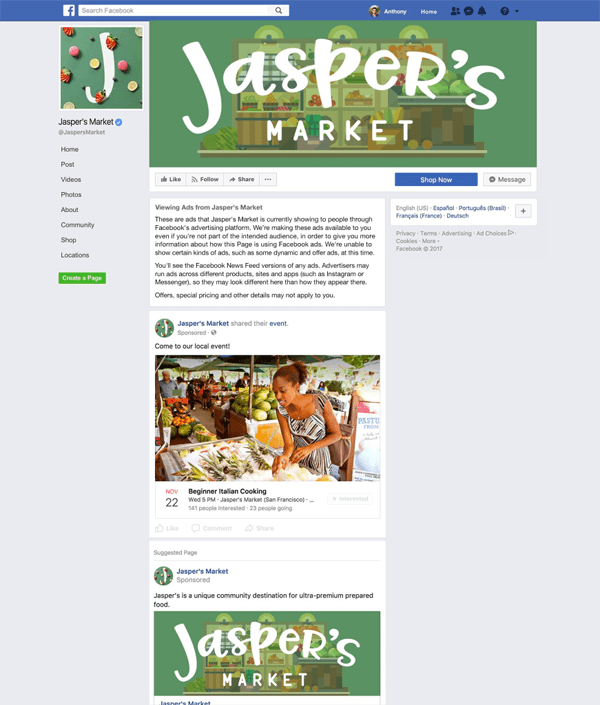Ask Anything About: Dark Posts

It can be difficult to keep up with every new term or technology available today. Instead of nodding along in agreement, however, it is important to ask questions that will truly help you understand what is being discussed - even if those questions are simplistic in nature.
For this reason, Website Magazine launched its "Ask Anything About" series (inspired by Reddit's popular Ask Me Anything threads) to pair some basic question about a topic with an expert who could answer them in greater detail. We're just getting started, so if you missed "Ask Anything About: Amazon," "Ask Anything About: Blockchain" or "Ask Anything About: Cybersecurity" check them out. Next up: Dark Posts (below). Coming soon: E-Commerce.
Our expert for "Ask Anything About: Dark Posts" is Shane Ragiel, Digital Media Director of Chacka Marketing. Let's get started.

What is a dark post on social media?
Shane Ragiel, Digital Media Director of Chacka Marketing: A dark post is a post that has been published for advertising use that is seen by select members of the public.
Any relation to the dark Web?

Ragiel, Chacka Marketing: No, it was simply terminology used to differentiate targeted posts from posts that were publicly shared and intended for mass audiences. For example, a brand might post a video on its page that highlights an upcoming event that's viewable by all of its fans or anyone visiting the page. This video is likely to have broad appeal and thus would remain a public post. A dark post on the other hand would likely contain messaging or content that's been targeted to a specific subset of individuals, and thus would have much narrower appeal and wouldn't be published for broad public consumption.
Why would anyone want to use a dark post in the first place?
Ragiel, Chacka Marketing: Dark posts were more a function of how Facebook designed its platform and offerings; advertisers used them because that's what was available to them. Essentially, dark posts contained advertising content like marketing messaging, were part of the advertising strategy, targeted to a specific group of Facebook users, often with a direct response component. In light of a recent Facebook change, advertising can still be targeted to specific groups of Facebook users, but what used to be a dark post can now been sought out and viewed by anyone.
What's the current status of dark posts on Facebook?
Ragiel, Chacka Marketing: Dark posts will be eliminated in Canada in November 2017 and in the U.S. in the summer of 2018. As with all prior global Facebook initiatives it will be a gradual rollout reaching different regions at different times. Once it's rolled out in each area, users will be able to view any active ads on a special tab of each advertiser's page.
Should these changes be of concern to social media managers (why/why not)?
Ragiel, Chacka Marketing: That really depends on an advertiser's perspective.
For some, the big concern is that this change makes advertisers' creative and digital strategies transparent to competitors. It's possible that a new level of insight will be available for anyone in the world to access quickly and easily, including how often advertisers update their messages, what the promotions calendar looked like in the past, etc.
The flip side of that is, for advertisers seeking insights into their competition's approach, this new transparency offers them the ability to collect and make sense of the new competitive intelligence available to them. Even if it's just surface-level data, they can use that to plan or adjust their own campaigns based on the publicly available information.
It's important to note, anyone viewing an advertiser's ads will only see what has already been published (not what will be published in the future), and no performance data (clicks, click-through rate, costs) or targeting parameters be available for public consumption.
Ultimately, this is just the latest change in the evolution of social advertising. Since it impacts everyone equally, we still enjoy a level playing field, but there are new opportunities to gain a leg up on the competition.
With these changes, how can dark posts be used to collect competitive intelligence?
Ragiel, Chacka Marketing: With the elimination of dark posts, each advertiser will have a tab added to their page that shows all of its ads currently running on Facebook. By navigating to this tab, anyone, including competitors can view the ads, and closely examine any creative materials like artwork, messaging, etc. From this, competitors can infer other aspects like targeting or retargeting based on what they find. For example, if an ad has copy like "We noticed you viewed these shoes," competitors will be able to tell that ad is designed for retargeting a shopper who clicked on a specific product. Through close analysis, competitors will be able to piece together a good amount of information on an advertiser's overall strategy.

(Image Source)
What advice do you have for marketers who relied on dark posts to tailor messaging to certain groups?
Ragiel, Chacka Marketing: Continue what has worked for you in the past. While ads will be more transparent soon, the likelihood of a user who has been targeted by a brand navigating to their active ads tab (see image above) and having a negative reaction to the targeting is probably fairly small. In fact, it's probably much less likely than a proven advertising strategy not delivering like it has in the past because of this change.
There are a couple of things to be cognizant of. First, as users now can review all active ads and determine why they've been targeted, it's more important than ever that advertisers are scrupulous about what's being published. Second, most advertisers use tags in the URLs they tie to their ads to track interactions for retargeting and attribution. With this new transparency, they should remove any targeting or bidding information in the published URL so as not to reveal more information than necessary.
Anything else you'd like to add?
Ragiel, Chacka Marketing: While there may be a small adjustment period for advertisers, this new level of transparency serves the greater good. Facebook is an ad platform, but it's also a social network and has to provide value to users as well as advertisers. By emphasizing transparency it helps ensure ads are credible, thereby adding credibility to the platform. If Facebook turned a blind eye to advertisers misleading users with ulterior motives, users would flee the social network. Now, if users encounters ads from advertisers they don't recognize, they can click on the brand page to get more info, see all its ads and gain a better understanding of who is targeting them and why.
Keep Reading:

Subscribe to Our Newsletter!
Latest in Social Media










